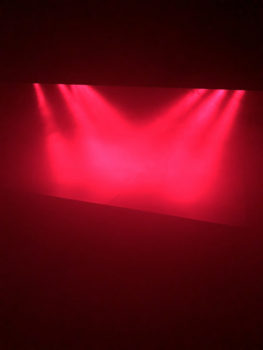[ad_1]

ARTNEWS
It’s been a big season for extremely dark rooms, what with Tania Bruguera’s Untitled (Havana, 2000) running at the Museum of Modern Art in New York in February and Adam Gordon offering up a barely lit space of his own at the Power Station in Dallas last month. And now, at Frieze New York, Marian Goodman Gallery (which always seems to make a special effort for this fair) has followed suit, enclosing its booth in darkness for a display of a classic 2002 piece by Pierre Huyghe, L’Expédition Scintillante, Acte 2, Untitled (Light Box).
That blackened booth also happens to be filled with smoke, I discovered, as I walked through thick black curtains into the room and turned on my phone’s flashlight, trying to see. Because of that smoke (generated by dry ice), that did not help too much, but I was able to make out two boxes that seem to hover atop one another near the center of the room, sandwiching a bit of what appeared to be empty air. It looked like nothing was happening, so I turned off my light and wandered around, feeling the walls, having some nice quiet time in the crowded fair.
Then someone entered holding an iPad and I forced myself to cough loudly so that this person would know I was there. (Don’t want to accidentally bump into anyone!) We both stood there, a couple of yards apart, staring at the box for a few minutes. And just when I was about to go back outside and start asking questions—“Maybe it’s not yet turned on!” I thought—bright red light began glowing from the space between the boxes. Swirling smoke poured from it and music—orchestral versions of Erik Satie’s Gymnopédies No. 3 and No. 4 (both 1888)—played, as the color shifted to various shades of bright yellow, orange, lavender, and dark navy, quickly rising and falling in intensity.
The machine was transfixing and alluring, and it also felt intriguingly dated, like some mid-century utopian contraption that had been unexpectedly discovered, plugged in, and—against all odds—found to be in fine working condition. Abraham Palatnik’s early Kinechromatic Devices from the 1950s came to mind, another example of a hand-fashioned art/science hybrid that conjures grand, hallucinogenic effects from distinctly analog means.
The dance of smoke and light continued for about six minutes, then quickly fell away. The room was dark again, still filled with smoke. But since my eyes had adjusted by now, I could see a little bit better now.
[ad_2]
Source link

